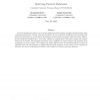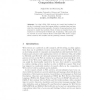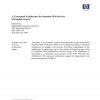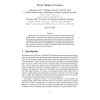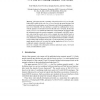76
Voted
SEMWEB
2004
Springer
15 years 5 months ago
2004
Springer
Faceted classification allows one to model applications with complex classification hierarchies using orthogonal dimensions. Recent work has examined the use of faceted classi�...
120
Voted
SEMWEB
2004
Springer
15 years 5 months ago
2004
Springer
In today’s Web, Web services are created and updated on the fly. It’s already beyond the human ability to analysis them and generate the composition plan manually. A number of...
95
Voted
SEMWEB
2004
Springer
15 years 5 months ago
2004
Springer
Web services are in the midst of making the transition from being a promising technology to being widely used in the industry. However, most efforts to use Web services have been m...
85
Voted
SEMWEB
2004
Springer
15 years 5 months ago
2004
Springer
86
Voted
SEMWEB
2004
Springer
15 years 5 months ago
2004
Springer
Turning the current Web into a Semantic Web requires automatic approaches for annotation of existing data since manual approaches will not scale in general. We here present an app...
73
Voted
SEMWEB
2004
Springer
15 years 5 months ago
2004
Springer
Service interface description languages such as WSDL, and related standards, are evolving rapidly to provide a foundation for interoperation between Web services. At the same time,...
96
Voted
SEMWEB
2004
Springer
15 years 5 months ago
2004
Springer
Both OWL-DL and function-free Horn rules3 are decidable logics with interesting, yet orthogonal expressive power: from the rules perspective, OWL-DL is restricted to tree-like rule...
98
Voted
SEMWEB
2004
Springer
15 years 5 months ago
2004
Springer
Abstract— Business processes involve interactions among autonomous partners. We propose that these interactions be specified modularly as protocols. Protocols can be published, ...
95
Voted
SEMWEB
2004
Springer
15 years 5 months ago
2004
Springer
Abstract. This paper presents a semantic web portal tool ONTOVIEWS for publishing RDF content on the web. ONTOVIEWS provides the portal designer with a content-based search engine ...
81
Voted
SEMWEB
2004
Springer
15 years 5 months ago
2004
Springer
Abstract. We have seen an increasing amount of interest in the application of Semantic Web technologies to Web services. The aim is to support automated discovery and composition o...
